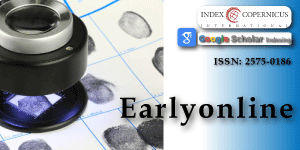Rosin's Edge in Forensic Odontology: A Staining Insight
Main Article Content
Abstract
Introduction: Forensic odontology is a specialized field at the crossroads of dentistry and law, focusing on the analysis of dental evidence in legal investigations. Due to their resistance to decay and environmental degradation, teeth serve as a vital resource in age estimation and gender determination. Various techniques, including microscopic examination of the incremental lines in enamel and cementum, neonatal lines, and dentin translucency, are commonly employed for forensic analysis. To enhance the accuracy and ease of examination, there is an increasing demand for high-quality, non-demineralized tooth sections that are durable, easy to handle, and maintain uniform thickness.
Aims and objectives: 1. Evaluate the effectiveness of the Rosin stain in identifying incremental lines in hard dental tissues. 2. Compare Rosin stain with Haematoxylin and Eosin stain as well as with unstained sections.
Materials and methods: Sixty sound teeth were included in the study. Thin longitudinal sections of 2 mm were prepared using a diamond disc, and ground sections of 25 µm were prepared on Arkansas stone. The sections were divided into three groups: (A) sections stained with Rosin, (B) sections stained with H&E, and (C) unstained sections. The longitudinal ground sections were examined under both the Light Microscope and the Phase Contrast Microscope. The Microstructures of the teeth, such as incremental lines of enamel, dentin, and cementum, were assessed.
Result and conclusion: Rosin-stained ground sections observed under phase contrast microscopy provided better visualisation of dental microstructures than unstained or H&E-stained ground sections, suggesting Rosin enhances the identification of incremental lines in forensic dental analysis.
Article Details
Copyright (c) 2025 Dang K, et al.

This work is licensed under a Creative Commons Attribution 4.0 International License.
Vyas T. Forensic Odontology: An Overview. Int J Drug Res Dent Sci. 2020;2(2):1–2. Available from: https://www.researchgate.net/publication/340779341_Forensic_Odontology_An_Overview
Gustafson G. Age determinations on teeth. J Am Dent Assoc. 1950;41:45–54. Available from: https://doi.org/10.14219/jada.archive.1950.0132
Sivapathasundharam B. Shafer’s Textbook of Oral Pathology. 9th ed. Elsevier; 2020. Available from: https://www.amazon.in/Shafers-Textbook-Oral-Pathology-Sivapathasundharam/dp/813125545X
Kugler S, Ossowicz P, Malarczyk-Matusiak K, Wierzbicka E. Advances in rosin-based chemicals: The latest recipes, applications and future trends. Molecules. 2019;24(9):1651. Available from: https://doi.org/10.3390/molecules24091651
Pradeep L, Kokila G, Gopinathan PA, Guruswamy S, Nazir SH, Chatterjee A. Age estimation with cemental annulation using light, phase contrast, and polarized microscopy. J Microsc Ultrastruct. 2021;9:55–60. Available from: https://doi.org/10.4103/jmau.jmau_3_20
Shah P, Velani PR, Lakade L, Dukle S. Teeth in forensics: A review. Indian J Dent Res [serial online]. 2019 [cited 2023 Mar 17];30:291–9. Available from: https://doi.org/10.4103/ijdr.ijdr_9_17
Jiang WZ. Preparation of the tooth grinding plate. Chin J Stomatol. 1956;4(4):319–22.
Sakoolnamarka R, Burrow MF, Kubo S, Tyas MJ. Morphological study of demineralized dentine after caries removal using two different methods. Aust Dent J. 2002;47(2):116–22. Available from: https://doi.org/10.1111/j.1834-7819.2002.tb00314.x
Pai VS, Nadig RR, Jagadeesh TG, Usha G, Karthik J, Sridhara KS. Chemical analysis of dentin surfaces after Carisolv treatment. J Conserv Dent. 2009;12(3):118–22. Available from: https://doi.org/10.4103/0972-0707.57636
Vikhe DM, Thete SG, Mastud CS, Mantri T, Mhaske PN, Mastud SP, et al. Staining the ground section of the tooth using an innovative plant stain found in the Pravara region, India. J Contemp Dent Pract. 2020;21(10):1113–6. Available from: https://pubmed.ncbi.nlm.nih.gov/33686031/
Oivanen M, Keulemans F, Garoushi S, Vallittu PK, Lassila L. The effect of the refractive index of fillers and polymer matrix on translucency and color matching of dental resin composite. Biomater Investig Dent. 2021;8(1):48–53. Available from: https://doi.org/10.1080/26415275.2021.1906879
Hariri I, Sadr A, Nakashima S, Shimada Y, Tagami J, Sumi Y. Estimation of the enamel and dentin mineral content from the refractive index. Caries Res. 2013;47(1):18–26. Available from: https://doi.org/10.1159/000342416
Carter DH, Scully AJ, Hatton PV, Davies RM, Aaron JE. Cryopreservation and image enhancement of juvenile and adult dentine mineral. Histochem J. 2000;32(4):253–61. Available from: https://link.springer.com/article/10.1023/A:1004059219242
Leite LSF, Bilatto S, Paschoalin RT, Soares AC, Moreira FKV, Oliveira ON, et al. Eco-friendly gelatin films with rosin-grafted cellulose nanocrystals for antimicrobial packaging. Int J Biol Macromol. 2020;165(Pt B):2974–83. Available from: https://doi.org/10.1016/j.ijbiomac.2020.10.189
Qin Q, Li Y, Zhou Y. An improved method for preparing stained ground teeth sections. PeerJ. 2023;11:e15240. Available from: https://doi.org/10.7717/peerj.15240
Aldas M, Pavon C, Ferri JM, Arrieta MP, López-Martínez J. Films based on materbi compatibilized with pine resin derivatives: Optical, barrier, and disintegration properties. Polymers. 2021;13(9):1506. Available from: https://doi.org/10.3390/polym13091506
Kugler S, Ossowicz P, Malarczyk-Matusiak K, Wierzbicka E. Advances in rosin-based chemicals: The latest recipes, applications, and future trends. Molecules. 2019;24(9):1651. Available from: https://doi.org/10.3390/molecules24091651
Pundir S, Saxena S, Aggarwal P. Estimation of age based on tooth cementum annulations using different microscopic methods. J Forensic Dent Sci. 2009;1:82–7. Available from: https://www.jfds.org/index.php/jfds/article/view/228





